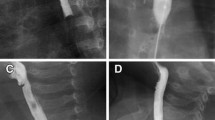Abstract
Esophageal dysmotility is a common occurrence after successful repair of esophageal atresia (EA) and tracheoesophageal fistula (TEF). The etiology of this motility disorder, however, remains controversial. Cine-barium esophagograms were performed in 25 survivors of EA/TEF at a mean age of 30.5 months. A clinical evaluation was done at the same time and the results were classified as “excellent”, “good”, and “fair”. The study revealed that 88% of patients had dysmotile esophageal segments and segmental contractions. Normal peristalsis was seen in only 16% of patients and 64% showed to-and-fro movements. The bolus transit time was delayed in 60%. The clinical status of these patients correlated well with the cine-radiographic findings. Thus, abnormal motility of the esophagus, which may be inherent, exists in postoperative survivors of EA/TEF and may be responsible for the clinical status of these patients.
Similar content being viewed by others
Author information
Authors and Affiliations
Additional information
Accepted: 8 November 1999
Rights and permissions
About this article
Cite this article
Dutta, H., Rajani, M. & Bhatnagar, V. Cineradiographic evaluation of postoperative patients with esophageal atresia and tracheoesophageal fistula. Pediatr Surg Int 16, 322–325 (2000). https://doi.org/10.1007/s003830000348
Issue Date:
DOI: https://doi.org/10.1007/s003830000348




